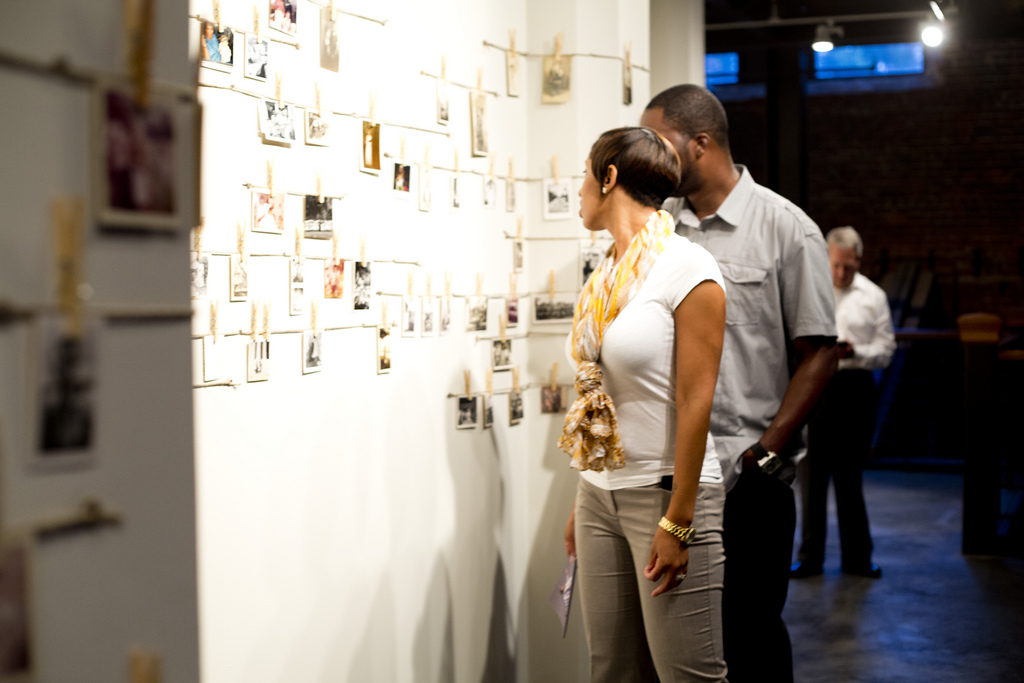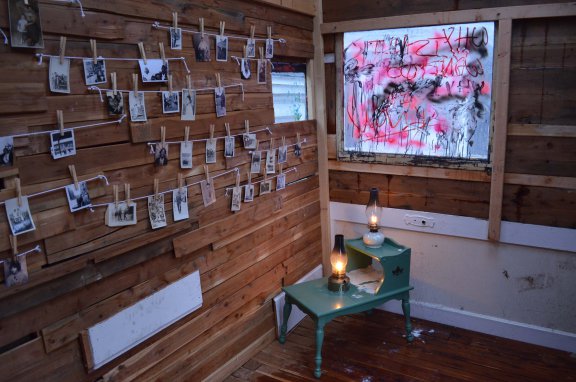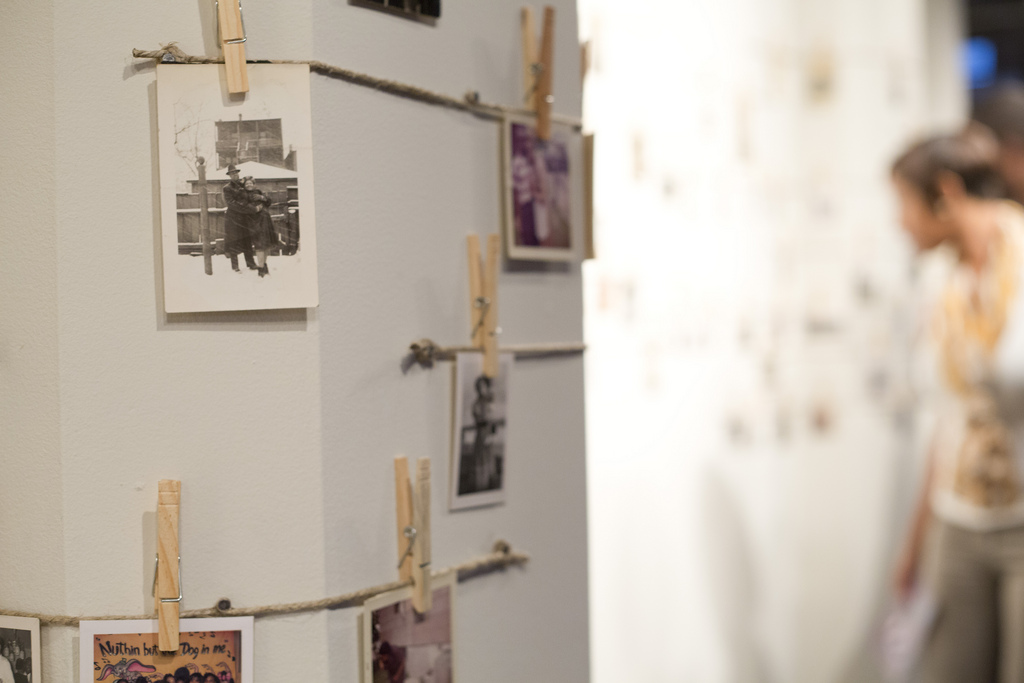
Art and history collide: an interview with Samantha Hill
The McColl Center for Visual Art is regularly a haven for talented and innovative artists, but current artist in residence, Samantha Hill, occupies a particularly unique space as she blends art and history in her site-specific installation projects. Hill’s methodology combines archival work, oral history, multimedia installations, public interaction, and performance. I sat down with Hill to find out more about her work and her plans for a future Charlotte installation.
Q: What inspired you to blend art and history in your installation work?
A: Approximately a year ago I started collecting photographs. I was inspired by my family; I come from a very large family. There were five generations alive at one time, and when the last person from that first generation passed on, she was a nurse in the army during World War II, I kind of hit that reality that, ok, there is a whole generation of my family that is just gone. And I wanted to do a project to tell her story.
So I started collecting photographs from WWII of African American soldiers. They were really expensive. I collected only three of them. At the same time I noticed this lot of random family photographs of African Americans that was really cheap, so I bought it on an impulse. When I opened up the package of family photographs, I saw that these photos were more interesting than the ones of the soldiers. One of the photos that was in that package was of a man from the 1970s; he has the big Afro and red velour – this was a really beautiful photograph. It tells so much about the period and the fact that he is Mr. Sauve with his scorpion chain. And then I started collecting more just for fun.
Q: So how did these photographs become installation art?
A: There was an open call at the Southside Hub of Production in Chicago, and the director, Laura Shaeffer, wanted me to do something at the center. My work is mostly project based, so I usually find subjects and then make the work, but I didn’t have any subjects at the time. I did have these photographs, about 200, so I thought let me string these up in the center and see if people will interact with them. I didn’t have the funds to put them in frames, so I came up with a clothes line rig to display them, and then hung them through the halls of the center. It was like an intricate map that led you through two floors of the building.
Q: How did people react?
A: A lot of people were confused. They would say, “Oh, this is not quite art; it is more history.” And the historians would say this is not history. I don’t know what this is.”
So I was trying to describe my practice at the time and doing a lot of research. I came across the story of the jeli or the grio. The jeli is the praise singer; he is a historian, and he basically tells the story of the tribe through song. And I thought that was interesting because I was essentially telling the stories of Chicago through my art. I decided to take on this persona and become the jeli.
Q: So that installation became “The Jeli’s Tale: An Anthology of Kinship”?
A: Yes.
Q: What did you do next with the photographs?
A: I interviewed a friend of mine’s mother and she talked about her life in Chicago, but then she mentioned the Great Migration. So I started thinking about that. I’m from Philadelphia originally, and my grandparents came up through the Great Migration, but on the East Coast people don’t talk about that. Chicago is different, people still have a strong connection to the South. People were more willing to talk about those stories.
So I did more interviews with Sherri Williams, the founder of the Bronzeville Historical Society, and Simba Tayari. I then linked all those stories together in one audio loop. I was also still collecting photographs, so I took the photos from 1916 to 1960 and added in photos donated from the participants I interviewed. I installed them in a shack made by Faheem Majeed on top of the Southside Hub. He made this shack to be his art center on top of the art center.
“The Great Migration” installation (interior) on the roof of the South Side Hub of Production by Samantha Hill.
I installed clotheslines with the photographs in the shack and put in kerosene lamps. The exhibit was open at night too, but there was no electricity, so people had to pick up the lamps to view the photographs. As soon as that happened people were really engaged because they had to get close to the photograph and hold up the lantern and pick and choose what they looked at. It was also really rainy during the exhibition, and the shack was made of cedar. It absorbed a lot of water, and the smell from the kerosene activated the cedar, so when you walked in it smelled like a cedar chest. There was water dripping from the rain, and it gave you this total experience.
Also we had a special performance called “A Gift to Warm the Body and the Soul” where one of the interviewee’s sons made crudités of his mother’s turkey and dressing with gravy and sage. He gave these to people before they entered the shack, so people got to a whole other level of interaction. They were actively viewing the photographs, holding the lanterns, smelling the cedar, listening to the rain and audio loop, and tasting home cooking.
Q: What was this installation called?
A: “The Great Migration.”
Q: So what is the project you are planning for Charlotte?
A: Well, one of the things I am here to experiment with are tintypes. I am interested in seeing how people react to an older, antique photography method. If you think of our culture right now, we document every single thing and post it online, but back then having your photograph taken was more of an event – it took more effort and consideration of what to wear and how to stand. So I want to take tintypes of people now, because when you stand in front of an antique camera, you are more aware of what you are doing compared to being photographed with your cell phone.
I am making my own plates for the tintypes and using a dry plate process so I can take the camera to locations. I am not interested in a studio practice. I want to show people in their own environments. So the project I will be doing here in Charlotte is experimenting with these tintypes and interviewing and documenting people from the Double Oaks neighborhood that is now being converted to Brightwalk, a planed mixed incoming housing community.
The Double Oaks neighborhood is not considered historic because it is less than 100 years old, but a lot of things have happened there that relate to the history of Charlotte. With the conversion to Brightwalk and re-building of homes, you are going to lose much of the memory about the neighborhood. Just think about what stories will be lost as people move away or pass on. With the community at the point of re-genesis how do we capture that transformation? How will we keep some of the old?
Q: Do you have a plan or vision for the shape or structure of the Charlotte installation?
A: No, my way of creating is to let the project unfold. It will depend on the participants I interview and photograph. It’s about them. My installations are experiential to activate all five senses at once, so I also want the viewers to take ownership of my projects. Have a conversation with each other. Get past the gallery etiquette and touch the art.
Q: So what is the end goal?
A: The conversation itself.
Some of the photographs Hill has been collecting over the past year are on view at the McColl Center of Art, strung up on clotheslines outside of her studio. She calls this collection “the Kinship Project,” and it now includes over 3000 candid and professional family photographs. You can check out her work at the next McColl Open Studio Saturday on November 9th. The Center is also open to the public on Thursdays and Fridays from 3-9 p.m.
“The Kinship Project” Samantha Hill. Photo courtesy of the McColl Center
This conversation represents an interview with Samantha Hill conducted on October 15, 2013 in her studio at the McColl Center. The interview has been edited for length and clarity.
Recent Content
-
Artsarticle ·
-
Artsarticle ·
-
Artsarticle ·



